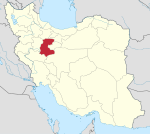Setaq
Appearance
Setaq
Persian: ستق | |
|---|---|
Village | |
| Coordinates: 35°02′52″N 49°17′40″E / 35.04778°N 49.29444°E[1] | |
| Country | Iran |
| Province | Markazi |
| County | Saveh |
| District | Nowbaran |
| Rural District | Bayat |
| Population (2016)[2] | |
• Total | 1,046 |
| Time zone | UTC+3:30 (IRST) |
Setaq (Persian: ستق)[a] is a village in Bayat Rural District of Nowbaran District, Saveh County, Markazi province, Iran.
Demographics
[edit]Population
[edit]At the time of the 2006 National Census, the village's population was 1,488 in 314 households.[4] The following census in 2011 counted 972 people in 285 households.[5] The 2016 census measured the population of the village as 1,046 people in 304 households. It was the most populous village in its rural district.[2]
See also
[edit]Notes
[edit]References
[edit]- ^ OpenStreetMap contributors (4 January 2025). "Setaq, Saveh County" (Map). OpenStreetMap (in Persian). Retrieved 4 January 2025.
- ^ a b Census of the Islamic Republic of Iran, 1395 (2016): Markazi Province. amar.org.ir (Report) (in Persian). The Statistical Center of Iran. Archived from the original (Excel) on 17 October 2020. Retrieved 19 December 2022.
- ^ Setaq can be found at GEOnet Names Server, at this link, by opening the Advanced Search box, entering "-3083145" in the "Unique Feature Id" form, and clicking on "Search Database".
- ^ Census of the Islamic Republic of Iran, 1385 (2006): Markazi Province. amar.org.ir (Report) (in Persian). The Statistical Center of Iran. Archived from the original (Excel) on 20 September 2011. Retrieved 25 September 2022.
- ^ Census of the Islamic Republic of Iran, 1390 (2011): Markazi Province. irandataportal.syr.edu (Report) (in Persian). The Statistical Center of Iran. Archived from the original (Excel) on 19 January 2023. Retrieved 19 December 2022 – via Iran Data Portal, Syracuse University.


